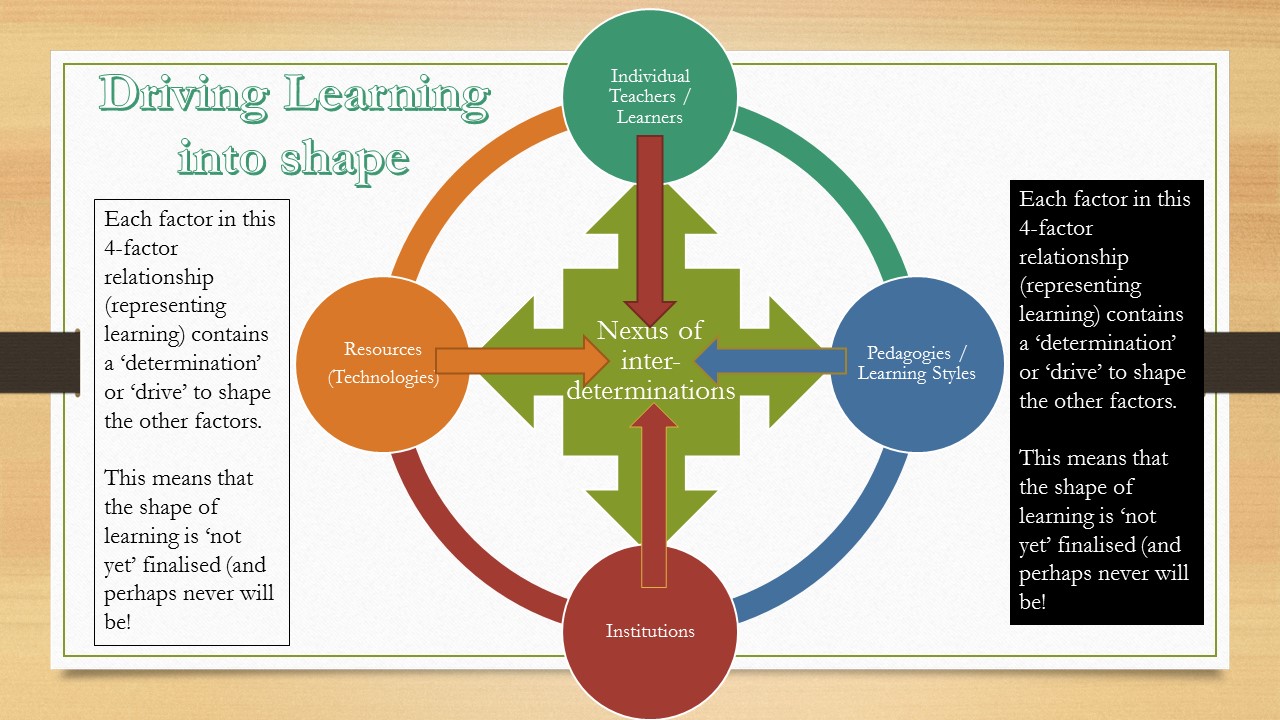Activity 21: The chicken and egg conundrum – technology and pedagogy inter-relate.
Use the forum to discuss the relationship between technology and pedagogic theory and practice, drawing on your own context and experience.
- What is your own experience and view?
- Do you regard either pedagogy or technology as more significant than the other?
- How do technology and pedagogy influence each other?
- Do you have experience where either technology or pedagogy has been given more weight than the other?
1. What is your experience and view
1.1. My experience of designing single learning activities, schedules of learning or modular courses is of a rather complex and muddled set of interacting determinations of which I become one (but not necessarily the dominant one). These were at their most complex in teaching social work where a group of stakeholders had an interest in the learning outcomes and processes and the meanings attached to both of these.
1.2. Hence my view can be ‘reduced’ (not altogether comfortably) into 2 messages about what drives learning design.
1.2.1. BI-DIRECTIONALITY.
1.2.1.1. I have difficulty seeing technology and pedagogy in a binary relationship where causative effect of one on the other is in one direction only – and I suppose the same goes for chickens and eggs.
1.2.1.2. Pedagogies are complexly driven and ‘prevailing’ or ‘emergent’ technologies will be one of these drivers.
1.2.1.3. The relationship between the drive of technology to ‘shape’ or ‘determine’ affordances is not simple. It is mediated by perception of what a technology is seen as capable of doing or being and what it isn’t capable of being or doing.
1.2.1.4. These mediating factors mean that any determination is not directly by the technology but by perceptions and translations of those perceptions into action by an agent capable of both perceiving and acting.
1.2.1.5. These mediating factors could be called the ‘affordances’ of the technology.
1.2.1.6. This is why, though a technological may not substantively change, what it is capable of being or doing can change or diversify immensely. These happens with blogs and so on.
1.2.1.7. All of those points (1.2 – 1.6) can be expressed inversely, e.g. ‘Technologies are complexly driven and ‘prevailing’ or ‘emergent’ pedagogies will be one of these drivers.
1.2.2. MULTI-FACTORIAL DETERMINATIONS.
1.2.2.1. Both pedagogies and technologies are determined and shaped by numerous and multiple other factors. Let’s consider two such factors:
1.2.2.1.1. Individuals. Whether as expert or user, teacher or learner, individuals help shape technologies. Whether as expert or user, teacher or learner, individuals help shape pedagogies.
1.2.2.1.2. Institutions / Groups. Individuals. Whether as commissioners or users, institutions and groups help shape technologies. Whether as commissioners or users, institutions and groups help shape pedagogies.
2. Is technology or pedagogy more significant?
2.1. The balance of significance changes in relation to the interplay of the different shaping factors at play in design of a learning event.
2.2. Sometimes, it may be that neither can be easily distinguished – in those cases we tend to detect extremes in the learning methodologies: from mechanical behaviourist conditioning to interaction without purposive boundaries or outcomes. In each extreme case, it rarely matters which is the lead determinant, because the range of affordances seen in each by the other has become extremely simple.
2.2.1. For the former, an example might be quiz-based learning.
2.2.2. For the latter, it might be improvisational role-play, without a reflective component.
3. How do they influence each other?
3.1. Complexly and bi-directionally. However, those mutual influences are never ‘pure’ of the effects of other drivers. I imagine the mutual influence occurring in a nexus of multiple determining factors.
3.2. In the diagram below, I simplify these ‘multiple’ factors to 4 in number, to reflect those mentioned in Weller (2011).
3.3. The concept of ‘affordance’ is always important, since affordance is a relationship of perception and action played out between different determining factors.

4. Back to experience!
4.1. In bad health and social care and support teaching and learning, I saw many instances of reductive uses of a dominant pedagogical lead.
4.2. This was complex because it enacted a psycho-dramatic and socio-dramatic conflict between the demands of professional practice in social work and thought proper to professional academics.
4.3. I find it difficult to be unbiased here, because my perception of the claims of the latter are coloured by my perception of the over-riding importance in the latter of group self-interest in the self-defining domain of academic professionals.
4.4. The claims of pedagogy as a lead principle too often represented, in my view (biased as it may be) that group self-interest.
4.5. In social work teaching pedagogical lead (even when supposedly learner-centric) often ignored the fact that social work (including its reproduction in teaching and learning) matters largely (to me entirely) in its outcomes for service users and carers (potentially, of course, all of us).
4.6. In simple terms, it lead to social work learners being untrained in the kind of e-technologies vital to effective interactions (whether administrative, planning or review-based or functional in working with human needs) that enable autonomy.
4.7. In more complex cases, it meant values and practices being dominated by theoretical constructs that only worked in situations that had to be moulded to the needs of the theory (the inverse of what theory is about).
4.8. This latter point needs elaboration. It has been brilliantly elaborated though in Ross’ (2016: 3-5) brilliant defence of a return to speculative models that prioritise values over over-simple ‘evidence-based’ theoretical constructs.
Ross, J. (2016) ‘Speculative method in digital education research’ in Learning, Media and Technology. Available from: http://dx.doi.org/10.1080/17439884.2016.1160927 (Accessed 07/04/2016).
Comments
New comment
Hi Steve
Interesting discussion - I do agree it is not a straightforward relationship between technology and pedagogy. There are many factors not least the learners needs and experience.
Cheers
Alan
New comment
I think the diagram is missing Government Policy, which greatly shapes our teaching practice and what we are free to do.